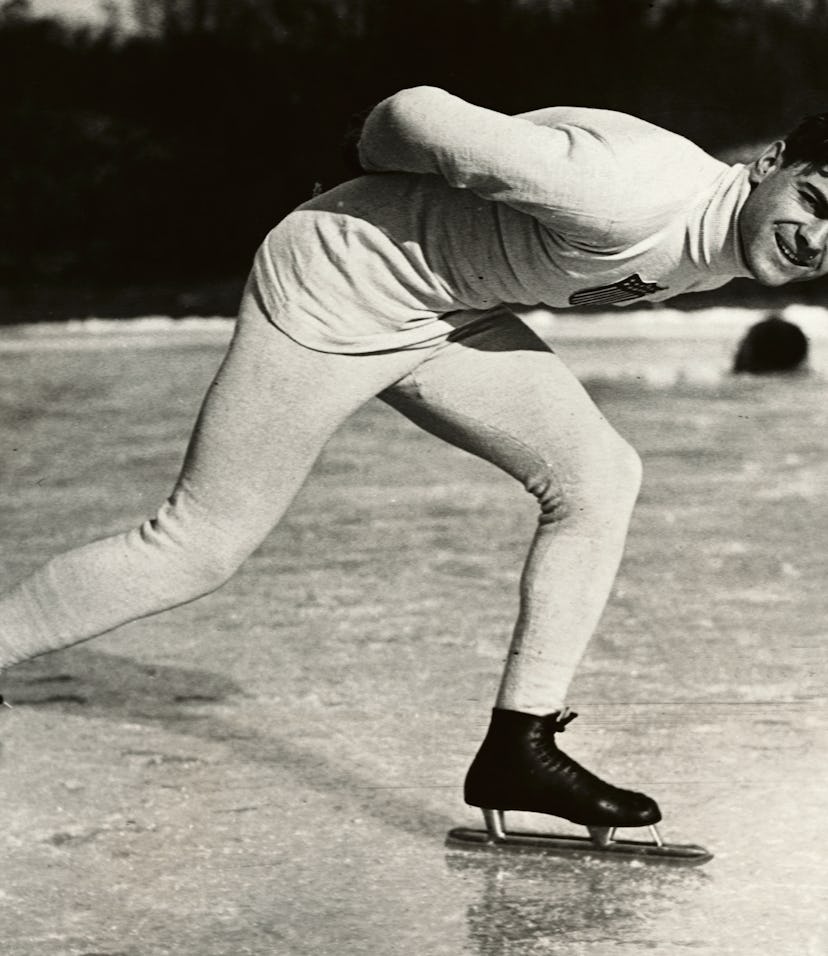The Olympics

Here’s How Olympic Speed Skating Uniforms Have Changed Over The Years
The skin suits weren’t always a thing.
The first winter Olympic games were held in 1924, which means that was the year the world started obsessing over the leotards, sweaters, and other looks athletes wore on the world stage. And while figure skating tends to be the winter sport that comes to mind first when thinking about memorable winter Olympics outfits, speed skating attire has been through lots of change in the last century too.
While the goal has always been to keep these speed demons warm on the ice, along the way they’ve shifted from all wool everything to Spandex, polarized glasses, and even Kevlar gloves. Now, they kind of resemble Frozone from The Incredibles, but that hasn’t always been the case. Below are some vintage speed skating lewks to reminisce about. (I’m partial to the hats, myself.) A lot of the changes were to help with wind resistance and make them even better skaters, which is pretty incredible. Still a disturbing lack of sequins though.
1924 Olympics
American speed skater Charles Jewtraw took home the first ever gold medal for speed skating in 1924. He sported a white-on-white uniform, in a turtleneck style for warmth, and black skates.
1932 Olympics
This Winter Games was the first when women were allowed to compete in speed skating. Kit Klein took home the gold medal in the 1,500-meter skate, and bronze in the 500. And she did it all in a warm uniform just like the men’s.
1952 Olympics
In the ‘50s, speed skating uniforms still included wool pants, sweaters, and caps to keep the athletes warm. In this photo, Japanese speed skaters Yoshiyasu Gomi and Kazuhiko Sugawara are wearing their tracksuits for practice, emblazoned with their country’s name across the chest.
1964 Olympics
Here’s Russian speed-skating legend Lydia Skobilikova taking a break from training while at the Games in Innsbruck that year. Her attire, like many skaters’, was beginning to become more form-fitting to reduce the wind resistance and help these elite athletes skate even faster.
1972 Olympics
By 1972, skaters were starting to wear something a lot more similar to what we see them compete in today. Known as skin suits, these one-piece uniforms are ultra tight, include gloves and a cap or hood, and help make the wearer as aerodynamic as possible.
1980 Olympics
Skin suits were in full effect in both men’s and women’s speed skating by the 1980 Winter Olympics. Here, American athlete Eric Heiden sports a pretty sweet all-gold unitard on his way to win a record-setting five gold medals in the sport.
1988 Olympics
Bonnie Blair won gold for the U.S. in the 500-meter event in 1988. That year, American skaters’ uniforms went bold with the pattern and color, and that’s been the trend ever since.
1992 Olympics
Here’s Bonnie Blair again, back for another stab at Olympic greatness and sporting an amazing ‘90s windbreaker and headband. The glasses she’s wearing here during a practice became popular for skaters to wear while competing to protect their eyes from the wind. Yep, they really do go that fast.
1998 Olympics
Helmets are now a mandatory part of short track speed skating, and many skaters today wear kevlar gloves and suits to prevent being cut by their competitors’ skates. This amazing flame-emblazoned skin suit belongs to South Korean Kim Dong-Sung, the gold medalist in the 1,000-meter short track event that year.
2002 Olympics
More color! Russian speed skater Svetlana Zhurova is pictured here wearing the country’s navy, pink, and yellow look for their first Olympics in the new millennium.
2010 Olympics
Anni Friesinger of Germany honestly looks like a superhero in her uniform at the 2010 Winter Games. While long-track skaters don’t have to wear helmets or gloves, eye protection has become mandatory.
2018 Olympics
Like the 2018 Chinese women’s speed skating team, most countries kept things a little more muted in terms of their uniforms. What will the trends be for 2022? You’ll have to watch the Winter Olympics in Beijing, kicking off on February 4.
This article was originally published on